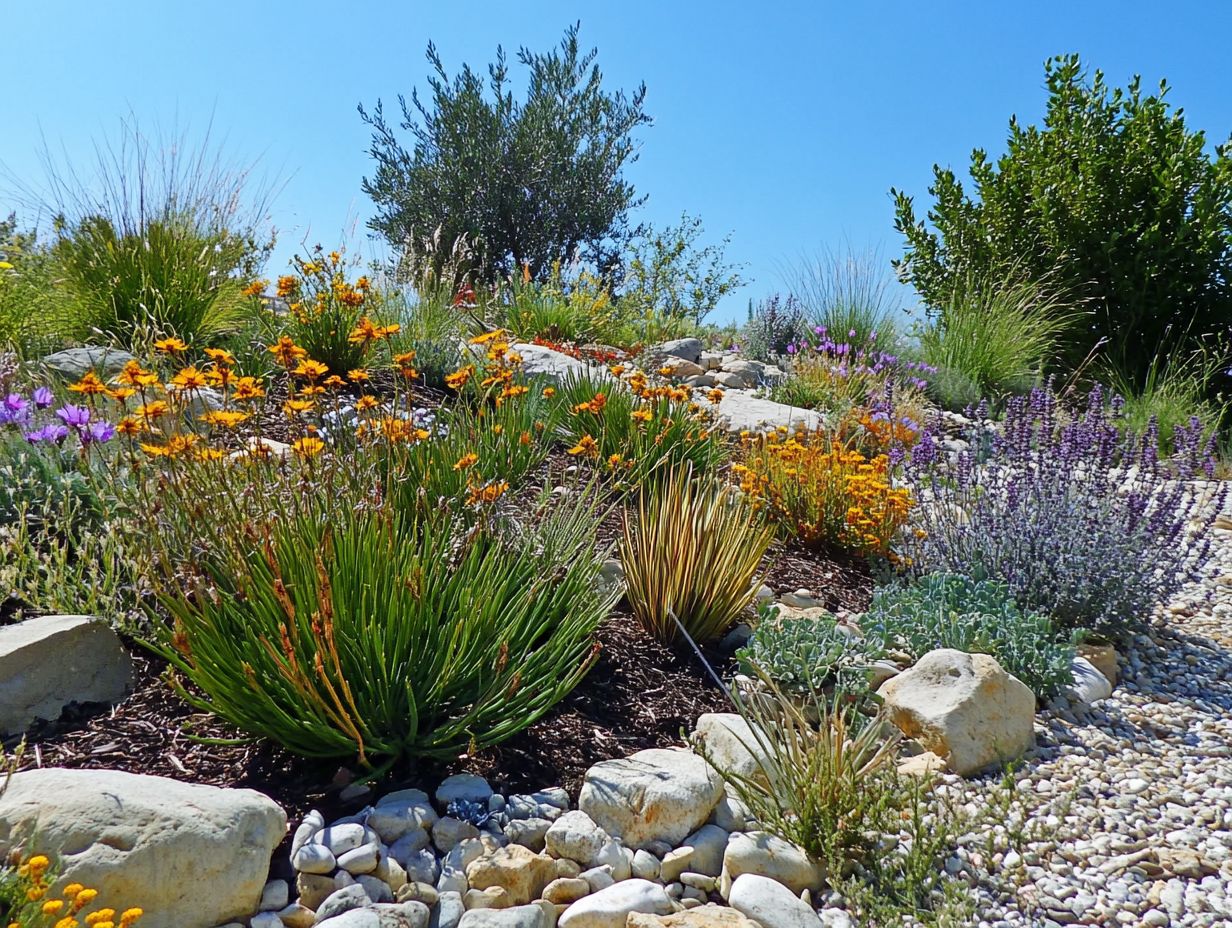5 Benefits of Xeriscape Landscaping
Are you seeking a way to elevate your garden while conserving water and minimizing upkeep? Discover the exciting world of xeriscaping! It may just be the ideal solution for you.
This eco-conscious approach not only conserves valuable resources but also promotes the growth of native plants, reduces chemical dependency, and can even enhance your property value.
You ll uncover the top five benefits of xeriscape landscaping, discover how it functions, and receive valuable tips for integrating it into your outdoor space.
Explore how this sustainable practice can transform your yard and create a positive impact on the environment.
Contents
Key Takeaways:

- Save water and money by implementing xeriscaping techniques!
- Reduce maintenance by choosing native plants and minimizing chemical use in your yard.
- Promote the growth of native plants and support local ecosystems through xeriscaping!
1. Saves Water and Money
Xeriscaping is an innovative landscaping approach that emphasizes water conservation, especially in areas like Texas, where drought conditions are a regular concern. By choosing drought-tolerant plants plants that can survive on minimal water and efficient irrigation systems, you can minimize water usage and lower your utility bills.
This sustainable design also tackles environmental challenges and dramatically reduces maintenance costs. It’s a smart investment in both your finances and environmental stewardship.
Consider this: you could see a reduction in your water bills by up to 50% after implementing xeriscaping, particularly in regions known for their sweltering heat and scarce rainfall. Native plants, perfectly suited to the Texas climate, require far less watering than non-native species, enabling you to save even more!
Plus, using drip irrigation systems watering systems that deliver water directly to the roots of plants means water goes directly to the roots, optimizing efficiency and cutting down on waste.
This combination of reduced utility costs and lower maintenance expenses since xeriscaped gardens generally need less frequent mowing, fertilizing, and pest control enhances the financial benefits of adopting best practices for drought-resistant landscaping, an eco-friendly strategy.
2. Requires Less Maintenance
One standout benefit of xeriscaping is its low-maintenance landscaping approach, allowing you to enjoy beautiful outdoor spaces while reaping the benefits of drought-resistant landscaping without the constant demands of traditional gardens.
By choosing xeriscaping, you can dramatically cut down on essential tasks like watering, which can often feel like a never-ending chore. Say goodbye to weekly mowing! Xeriscape designs frequently feature native plants that require minimal trimming. Fertilizing? That becomes a secondary concern since many xeriscape plants are perfectly adapted to local soil conditions and need fewer nutrients.
If you’re in Texas, consider incorporating easy-care plants like bluebonnets, agave, and lantana. These not only bring vibrant color and texture to your outdoor areas but also thrive with minimal fuss, making your landscape both stunning and effortlessly manageable!
3. Promotes Native Plant Growth
Xeriscaping encourages the growth of native plants, which are essential for enhancing the variety of plant and animal life in Texas landscapes and adapting to local environmental conditions.
Consider the vibrant Black-Eyed Susan with its cheerful yellow petals, the resilient Texas Sage that flourishes in arid areas, and the striking Desert Willow, celebrated for its stunning blossoms. Each of these plants brings a unique contribution to the ecosystem.
By incorporating such native flora, you not only reduce water consumption thanks to their impressive drought resistance but also create vital habitats and food sources for local wildlife, including pollinators like bees and butterflies.
Are you ready to transform your garden? By choosing these xeriscape plants, you can cultivate sustainable gardens that support local fauna while reveling in vibrant, low-maintenance landscapes that beautifully reflect Texas’s natural allure!
4. Reduces Chemical Use

Xeriscaping offers a remarkable opportunity to significantly reduce your reliance on chemical fertilizers and pesticides. By implementing this approach, you can change your landscape, minimizing environmental impact and nurturing a healthier outdoor ecosystem.
Choose native plants suited to your local climate. This fosters biodiversity and creates an inviting habitat for beneficial insects and wildlife.
Embracing xeriscaping allows you to play a vital role in creating a sustainable environment where water conservation takes center stage. For those looking for guidance, implementing 5 essential tips for drought landscaping can lead to long-term advantages, including enhanced soil quality, reduced runoff, and improved resilience of local ecosystems, better equipping them to face the challenges of climate change.
5. Increases Property Value
Investing in xeriscaping can substantially enhance your property value, especially as potential buyers increasingly seek out environmentally friendly and visually appealing landscaping options. Utilizing the right essential tools for drought landscaping can also make a significant difference.
This sustainable approach creates a beautiful exterior, conserves water, and reduces maintenance costs. It appeals to those who value both environmental impact and convenience.
According to a study by the National Association of Realtors, homes featuring xeriscaping often enjoy curb appeal boosts of up to 15%. Additionally, properties can see value increases of 20% or more in certain regions.
These impressive stats show how adopting xeriscaping practices can enhance drought landscapes, boosting your property’s beauty and resale value!
What Is Xeriscape Landscaping and How Does It Work?
Xeriscape landscaping offers a sustainable design approach that minimizes water usage while enhancing the beauty and resilience of your outdoor spaces. For those in drought-prone regions like Texas, consider 5 tips for building a water-wise garden to make the most of your landscape.
This innovative method encourages you to select drought-resistant plants, apply mulch, and implement efficient irrigation systems to reduce your reliance on limited water resources. By integrating various landscaping techniques, xeriscaping conserves water and elevates the visual appeal of your outdoor areas.
Create vibrant, low-maintenance landscapes that thrive even in arid conditions. This practice promotes biodiversity, providing habitats for local wildlife and educating communities about sustainable gardening that safeguards essential water resources.
What Are the Key Principles of Xeriscape Landscaping?
The key principles of xeriscaping center on effective water management and selecting appropriate plants, creating a sustainable and low-maintenance landscaping approach.
Begin with thoughtful planning and design to optimize this sustainable approach. Understand the unique characteristics of your environment, such as sunlight exposure and drainage patterns, allowing you to craft a cohesive layout.
Enhancing soil quality is essential for improving moisture retention and providing ideal conditions for plant growth. Choosing the right plants that thrive in arid conditions conserves water and fosters biodiversity.
Implement efficient irrigation methods, like drip systems a watering method that delivers water directly to plant roots, reducing waste. Incorporating mulch is vital for conserving soil moisture while suppressing weeds, creating a harmonious blend of elements that work together to cultivate a flourishing xeriscaped environment.
What Are the Different Types of Xeriscaping Techniques?

You can explore a variety of xeriscaping techniques to optimize water usage while enhancing the beauty of your landscape. These techniques include efficient irrigation systems and adding local plants.
For instance, implementing drip irrigation a system that delivers water directly to plant roots using small tubes minimizes waste and ensures moisture reaches where it s needed. You can also consider rainwater harvesting systems to collect and store rainwater. This not only supports your landscaping needs but also reduces reliance on the city water supply.
Choosing drought-tolerant plants allows you to conserve water while cultivating a resilient garden that thrives even in dry conditions. These approaches highlight the importance of thoughtful planning and using resources wisely in creating a sustainable and visually stunning outdoor space.
How Can Xeriscape Landscaping Benefit the Environment?
Xeriscape landscaping provides a unique opportunity to benefit the environment in various ways, such as promoting biodiversity, reducing water consumption, and minimizing the use of chemicals in gardening practices. Exploring understanding the benefits of xeriscaping can enhance your gardening practices even further.
This approach nurtures a diverse array of native plants and creates essential habitats for local wildlife, including pollinators and birds. Research shows that properties with xeriscaping can slash water usage by up to 50%, significantly easing the burden on municipal water resources.
According to a report from the Environmental Protection Agency, well-designed xeriscaped gardens can support a wider variety of species, enhancing local ecosystems and boosting their resilience, as highlighted in 5 ways drought gardening benefits your community.
By incorporating drought-resistant plants, you can create vibrant landscapes that not only flourish but also contribute meaningfully to the health of the environment around you.
What Are the Potential Disadvantages of Xeriscaping?
While xeriscaping has many advantages, be aware of potential drawbacks, such as initial installation costs and the ongoing maintenance needed to keep your landscape looking its best.
You may face challenges in selecting the right drought-resistant plants that thrive in your specific climate and soil conditions. Transitioning from a traditional garden to a water-efficient one can also affect the overall look, leading you to ponder the visual appeal of rocks and mulch instead of lush greenery.
However, you can overcome these hurdles by exploring native plants that not only require less water but also make a striking visual statement. Incorporating organic mulch enriches the soil and suppresses weeds. Establishing regular maintenance routines like pruning and fertilizing will enhance the overall appearance, seamlessly blending function with beauty.
How Can One Incorporate Xeriscape Landscaping into Their Yard?
Incorporating xeriscape landscaping into your yard requires a thoughtful design approach, tailored plant selection, and effective water management techniques suited to your unique outdoor spaces.
Start by assessing the specific conditions of your yard, such as sunlight exposure and soil type. This evaluation will help you choose the right xeriscape plants that thrive in your environment while minimizing water usage.
Some popular drought-resistant varieties to consider include:
- Succulents
- Native wildflowers
- Ornamental grasses
Once you have your plant list, sketch out a layout that highlights natural beauty while grouping plants with similar water needs together. Establish efficient irrigation methods, like drip systems or soaker hoses, to ensure water is delivered precisely where it s needed. This way, your xeriscaping project will be both sustainable and visually stunning.
Frequently Asked Questions

Explore the beauty of xeriscaping today! Start your xeriscaping journey or seek professional help to transform your landscape.
What is xeriscape landscaping?
Xeriscape landscaping is a sustainable method that creates water-efficient outdoor spaces. It uses native plants that thrive in the local climate and need minimal watering.
What are 5 benefits of xeriscape landscaping?
- Water conservation
- Cost-effectiveness
- Low maintenance
- Environmental friendliness
- Increased property value
How does xeriscape landscaping help with water conservation?
This landscaping method uses plants that need less water than traditional gardens. It also utilizes techniques like mulching, which involves covering soil to retain moisture, and efficient irrigation systems to cut down on water use.
Is xeriscape landscaping cost-effective?
Yes, it can save you money over time. By choosing native plants that require less water and upkeep, homeowners can lower their water bills and landscaping costs.
What makes xeriscape landscaping environmentally friendly?
This approach reduces the need for harmful chemical fertilizers and pesticides. Plus, it supports local ecosystems by using plants that naturally belong to the area.
Does xeriscape landscaping increase property value?
Absolutely! It enhances property value by offering low maintenance and cost-saving benefits. Plus, it boosts curb appeal, making your home more attractive to eco-conscious buyers.






